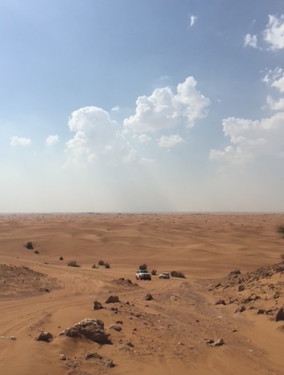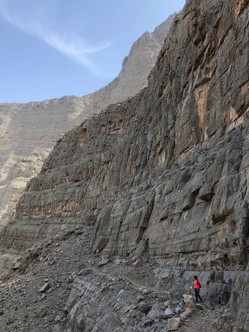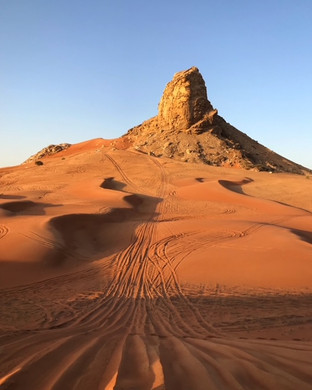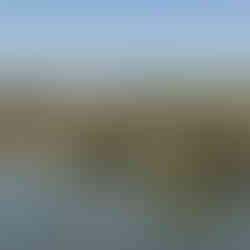Let's continue our list of 50 reasons to visit the UAE in its 50th year by heading into the Great Outdoors. There's a lot to do here away from the cities, with a surprising amount of natural diversity. We have beaches and desert of course, but we also have mountains and oases that are easy to get to and a world away from the skyscrapers of Downtown Dubai. Here are ten of my favourite ways to enjoy the outdoors here in the UAE, taking us from11 to 20 on our list.
11 Learning to drive off-road in the desert
Most of the touristy desert experiences will take you dune bashing where you're likely to be strapped into the back of a Landcruiser as the driver gleefully throws you around the dunes while you try not to hit your head on the ceiling. But if you're more of a driver than a passenger, and in possession of a UAE or international driver's license, you can enrol in a Desert Driving Course with the Emirates Driving Institute and learn how to do it yourself. It's a half-day course, beginning in a classroom with a uniformed instructor who will teach you about all the functions of your 4WD that are useful when you're driving a bit further than Waitrose, e.g. differential gears, 4WD low vs 4WD high, and the difference between a fashionable SUV and a functional (the former is more suited to the Waitrose run than tackling the dunes). Once you've realised what your car can actually do, it's time to head out into the desert in one of the EDI's cars (usually a Toyota Landcruiser or a Nissan Patrol, the latter so huge that you feel like you're driving your own living room around). First stop is to deflate the tyres to provide more traction, then it's headfirst into a dune where the instructor will sink the car into the deep, soft sand, and ask you to get it out. Which you will be able to do easily if you were paying attention in class. The next few hours will be spent with you at the wheel, learning how to read the dunes, how not to get stuck (you will, but it doesn't matter as now you know how to get out), how to really put your foot down as you tackle a high dune, and how to slow down at the peak so you don't fly off the other side, and what to do to stay safe out there. It's huge amounts of fun in a beautiful desert environment, and at the end of it I felt pretty much invincible, a combination of adrenaline and pride at having developed a new skill. You'll even get a certificate, which makes it feel like a proper, official achievement.
12 Hiking in Ras Al Khaimah
Ras Al Khaimah is the most mountainous of the seven emirates, home to the highest peak in the country (Jebel Jais, the summit of which lies just over the border in Oman). The mountains here are towering expanses of rock with very little vegetation, quite forbidding but also incredibly beautiful when set against the clear blue desert skies. There are plenty of different hikes to choose from in RAK, but for the most challenging you definitely need a guide or to go with a group of people who know what they're doing. My friend Tanya invited me to go on a hike in Wadi Ghalilah, and I have to say that I underestimated just how challenging it would be. If someone tells you that you will need hiking poles, take hiking poles, and make sure you have enough water and snacks to see you through. And start early - you don't want to find yourself scrambling up rocks in the midday sun. The Wadi Ghalilah hike took us four strenuous hours there and back, and what spectacular hours they were. The path is made up of scree in many places so those poles come in really handy, and you'll find yourself walking along a dry rocky wadi bed for part of it - careful of your ankles. The climb is steep and you'll find yourself walking along a towering rock wall at one point. We went as far as we could without actually traversing the mountain, and then headed back. You can see the layers of stratified rock on the mountainside, and it's easy to see how it must have been pushed up from the seabed millennia ago - this was all underwater at one point. Keep an eye out for fossilised seashells in the rocks along the trail, and friendly goats who will happily relieve you of any excess snacks at the end.
13 A walk through Wadi Shees
The Khor Fakkan Road connecting Sharjah with the east coast is one of the most beautiful drives in the UAE. The scenery gradually changes from golden dunes to gravel desert to high rocky mountain, and eventually to the beach and the Gulf of Oman on the other side of the peninsula. About an hour outside Dubai is Wadi Shees, a small oasis village in the mountains with an easily accessible walking trail. Follow the signs for the new Shees Park and leave the Khor Fakkan Road, continue past the park down the steep road into the bottom of the valley, and park your car at the bottom. From there, follow the sign for the old village, and you're on the hiking trail. It's a very easy walk, but a worthwhile one. You'll walk up some stone steps, pass through the village, and from there the trail heads into the date palm plantation where some of the trees are held up by metal crutches so they don't collapse under their own weight. A rickety ladder leans against one tree, although it'll need a few more rungs adding before anyone attempts to climb it for the next date harvest. It's a lovely walk, and there are sign boards along the way with facts about the area and QR codes to read more. Perhaps the loveliest aspect of the walk is that you follow the path of the falaj, the ancient irrigation system that keeps these oases green, and you'll be accompanied by the sound of running water. Pause for a moment by the water-collecting pool, and you'll see red dragonflies flitting in and out of the palm shadows. The whole walk will take you around 40 minutes. Not long, but long enough to feel refreshed by the beautiful green that surrounds you in this most barren-seeming location.
14 Explore the Al Ain Oasis
I'm not sure that this really qualifies as the "Great Outdoors", but the Al Ain Oasis is certainly a place where you'll be surrounded by greenery, and has even been recognised by UNESCO as a World Heritage Site. Al Ain itself is a lovely town with more roundabouts than I’ve ever seen in any other city, anywhere in the world. One you’ve navigated about 1,372 of them, you’ll find yourself in the centre of Al Ain, meaning "the spring", and should head towards the oasis where you can stroll in the shade of 147,000 date palms. It’s home to fully functioning date farms, irrigated by another of those ingenious falaj systems that we encountered in Wadi Shees, but this time on a much larger scale. 100 different varieties of dates are grown here (I had no idea so many different types existed), and you might also see banana plants too. There’s nothing like seeing dappled light shine through the palm fronds and you can wander at will, although don’t go stepping into someone’s farm without asking first. Pale yellow stone walls separate each farm, and also delineate the central path. If you’d like to see the oasis on two wheels you can rent bikes, and if you’d like to see them on four wheels, there’s a funny kind of two-seater bicycle contraption with a shady canopy that you can also rent. It looks like there are two drivers as both seats have a steering wheel in front of them, but a word of warning – only one of them actually works, so be careful who you put in the driving seat..! The oasis was only opened to visitors a few years ago, and it’s a great way of seeing how the potential of the desert was harnessed centuries ago – Al Ain has been inhabited for an incredible 4,000 years.
15 Magical Mleiha
Mleiha, in the Sharjah desert, is one of the places I love most in the UAE. When I first discovered it, it was if a whole new desert world had opened up to me. One with ancient tombs, outrageously photogenic scenery, a fascinating museum with a light-filled café, and a rock made entirely out of fossils. The drive on the old road through the dunes is beautiful - make sure you take this one, even if it makes the journey a little longer than taking the highway. It used to be the main thoroughfare connecting the two coasts, and as it twists and turns through the dunes you’ll need to keep your eyes open for camels – they wander freely here, and can often be found sauntering in the middle of the road. When I discovered that the team at the Mleiha Archaeological Centre will organise a private desert lounge for you, preceded by a sunset drive through the dunes and a stop at Fossil Rock, I immediately made a booking. And it's a delight. You can lounge in your Bedouin-style tent, see the moon, planets and stars through a high-powered telescope, enjoy a barbecue dinner, and when you first see the set-up it’s hard to believe the whole thing can possibly be just for you. Apparently they will also be opening an overnight camp sometime this year. Our guide, Anurag from the Education team, taught us so much about the solar system that we’d never known before, and very patiently answered all of the questions we bombarded him with. It's a really special way to spend an evening. Keep an eye out for announcements of meteor showers too - Mleiha is a great place to see them, and the Centre often arranges viewing events.
16 Navigate the hairpin bends of Jebel Hafeet
With a not very vertiginous altitude of 1,249 metres, Jebel Hafeet is the second highest mountain in the country, and the drive to the top is one of the ten best in the world, according to the informational sign at one of the viewpoints on the way. This seems a fairly bold claim when you compare it to some of the Alpine or Andean routes, but it’s definitely one of the ten best in the country, if not one of the two best. It’s not all that long – around 13km from bottom to top – but when you get to the car park at the summit you have sweeping views over Al Ain and Oman beneath. Aside from admiring the view, there’s a retro little café at the top with a couple of claw grab games and some rides for very little kids. Drive up in the late afternoon when the shadows make you look as if you’re 50 feet tall, and leave the summit before sunset. There’s a Mercure hotel on the way down (also fairly retro) with a bar outside where you can stop for a beer for the passenger and a coffee for the driver as you watch the sun set and the lights twinkle in the towns below. Combine it with your trip to Al Ain for a grand day out.
17 Tackle the Jebel Jais mountain road
Giving Jebel Hafeet a run for its money in terms of best mountain drives, Jebel Jais pips the former at the post by being the highest mountain in the country, and also being home to the world’s longest zip line. Try it if you dare. I didn’t – call me a wuss, but a 2.8km metal cable strung over a gaping chasm has never seemed like a great idea to me, especially one that withstands the extreme temperatures and year-round sunshine that you get up here. I’m happy to stick to the drive, which is thrilling enough with its curves, climbs and hairpin bends, and the views are so spectacular you’ll need to force yourself to keep your eyes on the road. Fortunately there are plenty of rest stops on the way up (some with loos should you find yourself caught short) and I’d suggest stopping at all of them as the views are different from each one. The top of the mountain is reserved for those with reservations on the zip line, or for those with a booking at Puro 1484, a new restaurant that is also the UAE’s highest, since we love superlatives over here. There’s a small park from where you can see all the way down to the coast, and next to the car park are a couple of food trucks where you can get coffee and ice cream, and stare at the frankly jaw-dropping views before you head back down again.
18 Jubail Mangrove Park
For a change of pace, head to the new Jubail Mangrove Park on Jubail Island in Abu Dhabi, just between Yas Island, home to Ferrari World and the F1 race, and Saadiyat Island, home to the Louvre Abu Dhabi. If there’s anywhere you can breathe in the benefits of negative ions in such proximity to the city, it’s here. The park spreads over one million square metres of protected mangrove forest, and a two-kilometre boardwalk takes you on a loop over turquoise waters dotted with green trees. Make sure you time your visit for high tide as low tide can appear somewhat muddy – the website very helpfully lists the timings for you. You can also join an educational kayak or canoe tour – the park’s aim is that every visitor should go home having learnt at least one new thing. I learnt many more than that. I learnt that mangrove seeds drop once a year in September when they start to germinate and new trees grow. Eventually they will die and new ones will replace them – you’ll see trees at every stage of their life cycle in the park. Mangroves store 5-6 times more carbon than rainforest trees, and so play a vital role in the mitigation of climate change, and also create a natural barrier between the sea and the land, useful in areas prone to high tides and tidal waves – the structure of the mangrove canopy and root system dissipates the energy of strong waves. They’re also a breeding ground for fish and crabs, including the nattily named four-lined terapon, rabbit fish and ghost crab, and keep your eyes open for western reef herons and flamingos.
19 Birdspotting at Ras Al Khor Wildlife Sanctuary
Speaking of flamingos, large flocks make the Ras Al Khor Wildlife Sanctuary their home, along with another 180 species of birds who are either residents or visitors. Perhaps the most surprising thing about this sanctuary is the proximity of it to the centre of the city – it’s just a few kilometres from Downtown Dubai, and the Burj Khalifa and the city skyline form an unexpected backdrop. Visit in winter for large populations of migrating birds who come here for the milder temperatures. A number of hides are set up from which you can peer out at the birdlife. Aside from flamingos, I’ve seen spoonbills, egrets, herons, cormorants and plovers, and if you’re lucky you might spot a kingfisher too. For more birdspotting opportunities, head to the manmade lakes of Al Qudra where you're also likely to see gazelles, or just take a stroll around the green and flower-filled residential neighbourhood of Jumeirah (where I live). Here I regularly see hoopoes with their jaunty orange mohawks, melodious white-eared and red-vented bulbuls, a flash of turquoise as an Indian roller swoops past, often making the most incongruous hissing noise that really doesn't suit its beauty, emerald green green bee-eaters, chattering mynahs, squawking ringed parakeets, and little purple sunbirds. It's worth sitting quietly for a while and just watching who comes to visit.
20 Riding the waves in Ghantoot
Last but not least, number 20 on my list is down in Ghantoot where I wakesurf. Yes, you can wakesurf in Dubai Marina but you’ll be competing with other wakeboarding boats, jet skis and yachts, and the water is likely to be choppy. But in Ghantoot, just over the border in the emirate of Abu Dhabi, you'll have the water all to yourself. On certain days when there’s not a breath of a breeze it’s like glass; on other days there may be a couple of bumps but nothing that should really stop you from surfing, unless it’s a really windy day. The small (and in need of a little love) Ghantoot Marina is located on a manmade channel at the end of which is a naval base, meaning there is practically no traffic. It’s fairly narrow so occasionally you meet your own wake when the boat changes direction, but it’s the quietest, calmest place I’ve ever surfed, and is perfect for beginners. The only time you’ll find your surfing restricted is when the King of Bahrain is in residence – he has a palace along the waterfront, the only significant building here other than an abandoned hotel which looks like something out of a Star Wars film. If you love to get out on the water to wakeboard or wakesurf, this is undoubtedly the best place in the country. But let’s keep it a secret. There’s only one wake operator there and the more people know about, the fewer surfing spots there will be for me..!




























































Comments